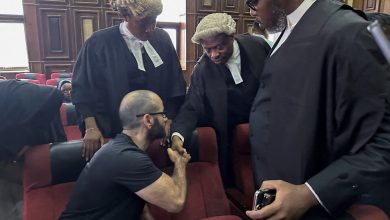Why ‘Trust Us’ Is Often Reason Enough Not to Trust the Government

WASHINGTON — The dramatic national security stories recounted in two official news briefings on Thursday centered on very different subjects, but they featured the same indignant pushback to questioning reporters: just trust us, unless you are more inclined to believe America’s enemies.
Pressed for evidence supporting an official narrative about how children had died during a commando raid in Syria — specifically, that an ISIS leader’s bomb, not American forces, had killed them — the White House press secretary, Jen Psaki, seemed to bristle at a suggestion that people might be dubious about the civilian casualties.
“Skeptical of the U.S. military’s assessment when they went and took out an ISIS terror — the leader of ISIS?” Ms. Psaki said. “That they are not providing accurate information and ISIS is providing accurate information?”
And pushed for evidence supporting his announcement that intelligence showed that Russia had plans to manufacture a pretext to invade Ukraine — a fake video, with hauled-in corpses and “crisis actors,” to frame the Ukrainian military for a genocidal attack on Russian speakers — the State Department spokesman, Ned Price, sharply rejected the idea.
“We declassify information only when we’re confident in that information,” Mr. Price said. “If you doubt the credibility of the U.S. government, of the British government, of other governments, and want to, you know, find solace in information that the Russians are putting out — that is, that is for you to do.”
In the most sensitive and consequential government operations, the public is beholden to the narrative of officials — which sometimes turns out to be wrong. Yet officials can be defensive about skepticism from the news media, as unfolded twice on Thursday.
That poses a particular dilemma for journalists who cover national security and who are once again in the uncomfortable position of having to rely on top government officials for the first cut of what happened. What the officials say is news to be reported, but it is often impossible to independently verify the details right away.
And history shows that the early official narrative about big national security events is often wrong. Sometimes, the fog of war leads to murkiness that has confused even the government officials, but officials may also be in situations where they have an incentive to put a spin on the facts.
In August, the United States carried out a drone strike in Kabul amid the evacuation from Afghanistan, and the military announced that it had thwarted would-be ISIS-K suicide bombers. Even as reports emerged of civilian casualties, including children, Gen. Mark A. Milley, the Joint Chiefs of Staff chairman, insisted the strike was “righteous.” Only later, after a video investigation by The New York Times showed that the person targeted was an innocent aid worker, did the Pentagon acknowledge that the strike had been a tragic mistake and that no ISIS-K fighters had been killed.
In 2011, when the Obama administration announced the commando raid in Pakistan that killed Osama bin Laden, the president’s chief counterterrorism adviser, John O. Brennan, said the Qaeda leader had engaged in a firefight and used his wife as a human shield. Days later, the White House walked back its account, saying that bin Laden had been neither armed nor cowering behind a woman.
During the buildup to the 2003 invasion of Iraq, officials in President George W. Bush’s administration famously put forth intelligence about purported Iraqi weapons of mass destruction that turned out to be inaccurate. They also stoked baseless fears that Iraq’s secular dictator, Saddam Hussein, was collaborating with the religious extremists behind the Sept. 11 attacks, Al Qaeda.
During the wars in Vietnam and, more recently, in Afghanistan, administration officials under both parties often issued a more optimistic picture of progress to the public than the government’s internal assessments supported. And President Lyndon B. Johnson justified an escalation of the war in Vietnam based on a supposed North Vietnamese attack on an American vessel in the Gulf of Tonkin that never happened.
Recognizing that the American government has not always shared credible information and that its statements in such situations should be approached with skepticism is different from equating the United States to ISIS or to Russia, which is notorious for disinformation operations — including a propaganda campaign suggesting that Ukraine is guilty of genocide against its Russian-speaking citizens.
And there are differences that may lend a greater presumption of credibility to the U.S. government’s current claims. The situation on the border between Ukraine and Russia is not like Vietnam or Iraq, for example, in that the United States is trying to deter a conflict, rather than justify or start one.
Moreover, in the raid in Syria, accounts on the ground largely dovetail with the official narrative that U.S. commandos were on bullhorns trying to get civilians safely out of the building under assault. Photographs also confirm there was an explosion on its third floor.
Still, against the backdrop of historical inaccuracies in the American government’s official presentation of the facts after high-profile counterterrorism operations in which civilians were killed, or during the period of information warfare that can precede a shooting war, many reporters tend to be loath to simply accept the government’s word.
At a White House briefing on Friday, a reporter raised Ms. Psaki’s and Mr. Price’s comments and asked Ms. Psaki whether she truly believed that journalists were repeating Russian and Islamic State propaganda in seeking evidence for claims by the American government.
Ms. Psaki replied that she and the administration welcomed “tough questions and good-faith scrutiny” and that they “respect and value the role of the press.” She added that on Thursday, she had gone on to note — in comments omitted from some clips of the exchange that circulated afterward — that the Pentagon was still analyzing a strike that had unfolded less than 24 hours earlier and would “provide every detail they can.”
The Pentagon spokesman, John F. Kirby, told NPR on Friday that he was unable to predict whether video of the operation would be disclosed. But he reiterated that the explosion was caused by the detonation of a bomb by the ISIS leader — citing initial debriefings of the commandos who participated in the operation.
“They’ve laid bare what they saw and what they did,” he said. “We’re very confident that the explosion on the third floor happened well before the assaulting force even got into the building. Certainly, there was no airstrike conducted.” He added that the explosion “was definitely the result of” the ISIS leader’s action.
For his part, Mr. Price noted in an interview that when he displayed exasperation with the reporter pressing him for evidence underlying his announcement that Russia had plans to fake a video of a Ukrainian atrocity, he was addressing a room full of experienced reporters who he knew already understood that the government tries to protect sensitive intelligence sources and methods — and why.
He would not provide details about how particular sources could be damaged, but national security officials have provided examples in other contexts. For instance, making public specific intercepted phone calls or emails serves notice to adversaries about which particular communications channels are likely compromised — so they stop using those channels, which dry up as sources of further useful information.
“What we are trying to do is strike a balance between transparency about what we know with an eye to deterring Russian aggression — or in the event we are not able to do that, to shining a spotlight on the fact that the Russians sought to have a pretext all along for their aggression — while at the same time protecting our ability to collect this kind of information going forward,” Mr. Price said.
He added: “It is not an easy balance to strike. It is, I’m sure, an unsatisfactory balance for journalists and some members of the public. But as the custodians of American national security, it’s the balance that we have to do.”
In a separate interview, Ms. Psaki struck a more conciliatory tone, stressing that from a spokesperson’s perspective, it would be easier to be able to release every detail. She also said that after the briefing on Thursday, she contacted the reporter who had questioned her; she said she told the reporter that it was not her intention to undervalue the question and that “if you felt that way, I apologize.”
Indeed, the Biden administration has walked back an important nuance in its presentation of the official understanding of the facts of the crisis between Russia and Ukraine. In recent weeks, Ms. Psaki and Mr. Kirby used the word “imminent” or “imminently” in official briefings about the prospect of a Russian invasion of Ukraine.
But Ukrainian officials complained that American messaging was too heated and alarmist, and this week, Ms. Psaki said the administration had stopped using that word.
“I used that once,” she said. “I think others have used that once. And then we stopped using it because I think it sent a message that we weren’t intending to send, which was that we knew that President Putin had made a decision. I would say the vast majority of times I’ve talked about it, we said, ‘He could invade at any time.’ That’s true; we still don’t know that he’s made a decision.”




